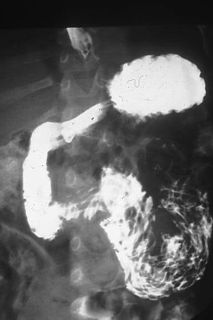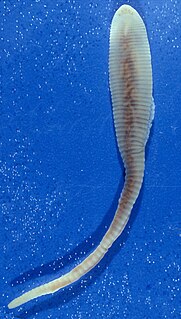Related Research Articles

Trichinosis, also known as trichinellosis, is a parasitic disease caused by roundworms of the Trichinella type. During the initial infection, invasion of the intestines can result in diarrhea, abdominal pain, and vomiting. Migration of larvae to muscle, which occurs about a week after being infected, can cause swelling of the face, inflammation of the whites of the eyes, fever, muscle pains, and a rash. Minor infection may be without symptoms. Complications may include inflammation of heart muscle, central nervous system involvement, and inflammation of the lungs.

Ascariasis is a disease caused by the parasitic roundworm Ascaris lumbricoides. Infections have no symptoms in more than 85% of cases, especially if the number of worms is small. Symptoms increase with the number of worms present and may include shortness of breath and fever in the beginning of the disease. These may be followed by symptoms of abdominal swelling, abdominal pain, and diarrhea. Children are most commonly affected, and in this age group the infection may also cause poor weight gain, malnutrition, and learning problems.
Gnathostomiasis is the human infection caused by the nematode (roundworm) Gnathostoma spinigerum and/or Gnathostoma hispidum, which infects vertebrates.

Necator americanus is a species of hookworm commonly known as the New World hookworm. Like other hookworms, it is a member of the phylum Nematoda. It is an obligatory parasitic nematode that lives in the small intestine of human hosts. Necatoriasis—a type of helminthiasis—is the term for the condition of being host to an infestation of a species of Necator. Since N. americanus and Ancylostoma duodenale are the two species of hookworms that most commonly infest humans, they are usually dealt with under the collective heading of "hookworm infection". They differ most obviously in geographical distribution, structure of mouthparts, and relative size.
Trichinella spiralis is a viviparous nematode parasite, occurring in rodents, pigs, bears, hyenas and humans, and is responsible for the disease trichinosis. It is sometimes referred to as the "pork worm" due to it being typically encountered in undercooked pork products. It should not be confused with the distantly related pork tapeworm.

The Toxocaridae are a zoonotic family of parasitic nematodes that infect canids and felids and which cause toxocariasis in humans. The worms are unable to reproduce in humans.

Visceral leishmaniasis (VL), also known as kala-azar or "black fever", is the most severe form of leishmaniasis and, without proper diagnosis and treatment, is associated with high fatality. Leishmaniasis is a disease caused by protozoan parasites of the genus Leishmania.
Spirometra erinaceieuropaei is a parasitic tapeworm that infects domestic animals and humans. The medical term for this infection in humans and other animals is sparganosis. Morphologically, these worms are similar to other worms in the genus Spirometra. They have a long body consisting of three sections: the scolex, the neck, and the strobilia. They have a complex life cycle that consists of three hosts, and can live in varying environments and bodily tissues. Humans can contract this parasite in three main ways. Historically, humans are considered a paratenic host; however, the first case of an adult S. erinaceieuropaei infection in humans was reported in 2017. Spirometra tapeworms exist worldwide and infection is common in animals, but S. erinaceieuropaei infections are rare in humans. Treatment for infection typically includes surgical removal and anti-worm medication.
Sparganosis is a parasitic infection caused by the plerocercoid larvae of the genus Spirometra including S. mansoni, S. ranarum, S. mansonoides and S. erinacei. It was first described by Patrick Manson from China in 1882, and the first human case was reported by Charles Wardell Stiles from Florida in 1908. The infection is transmitted by ingestion of contaminated water, ingestion of a second intermediate host such as a frog or snake, or contact between a second intermediate host and an open wound or mucous membrane. Humans are the accidental hosts in the life cycle, while dogs, cats, and other mammals are definitive hosts. Copepods are the first intermediate hosts, and various amphibians and reptiles are second intermediate hosts.

The Pentastomida are an enigmatic group of parasitic arthropods commonly known as tongue worms due to the resemblance of the species of the genus Linguatula to a vertebrate tongue. They are traditionally seen as crustaceans, even if that position has been questioned.
Diphyllobothriasis is the infection caused by tapeworms of the genus Diphyllobothrium.

Ancylostomiasis is a hookworm disease caused by infection with Ancylostoma hookworms. The name is derived from Greek ancylos αγκύλος "crooked, bent" and stoma στόμα "mouth".

Angiostrongylus cantonensis is a parasitic nematode (roundworm) that causes angiostrongyliasis, the most common cause of eosinophilic meningitis in Southeast Asia and the Pacific Basin. The nematode commonly resides in the pulmonary arteries of rats, giving it the common name rat lungworm. Snails are the primary intermediate hosts, where larvae develop until they are infectious.

Thelaziasis is the term for infestation with parasitic nematodes of the genus Thelazia. The adults of all Thelazia species discovered so far inhabit the eyes and associated tissues of various mammal and bird hosts, including humans. Thelazia nematodes are often referred to as "eyeworms".

Porocephalus crotali is a parasitic crustacean from the group Pentastomida, also known as tongue worms.
Gnathostoma hispidum is a nematode (roundworm) that infects many vertebrate animals including humans. Infection of Gnathostoma hispidum, like many species of Gnathostoma causes the disease gnathostomiasis due to the migration of immature worms in the tissues.

Linguatulosis is a condition associated with the organism Linguatula serrata.

Armillifer armillatus is a species of the genus Armillifer occurring in tropical Africa. Its typical definitive hosts are pythons, such as the African rock python, while rodents are presumed to act as intermediate hosts. Humans may become accidentally infected by the eggs particularly if consuming infected snakes. Ingested eggs develop into nymphs that invade different visceral organs causing a disease called porocephalosis. Most human infections are asymptomatic, some are debilitating, or rarely even lethal.

Armillifer grandis is a species of the pentastomid genus Armillifer distributed in tropical Central and West Africa. Its typical definitive hosts are viperid snakes, while rodents are presumed to act as intermediate hosts. Humans may become accidentally infected by the eggs, particularly if consuming infected snakes. Ingested eggs develop into nymphs that invade different visceral organs, causing a disease that is often called porocephalosis. Most human infections are asymptomatic, some are debilitating, or rarely even lethal. Abdominal infections are more widespread, but typically undiagnosed, while ocular manifestations are rare and may cause blindness.

Baylisascaris shroederi, common name giant panda roundworm, is a roundworm (nematode), found ubiquitously in giant pandas of central China, the definitive hosts. Baylisascaris larvae in paratenic hosts can migrate, causing visceral larva migrans (VLM). It is extremely dangerous to the host due to the ability of the parasite's larvae to migrate into brain tissue and cause damage. Concern for human infection is minimal as there are very few giant pandas living today and most people do not encounter giant pandas in their everyday activities. There is growing recognition that the infection of Baylisascaris shroederi is one of the major causes of death in the species. This is confirmed by a report stating that during the period of 2001 to 2005; about 50% of deaths in wild giant pandas were caused by the parasite infection.
References
- 1 2 3 4 Dennis Tappe & Dietrich W. Büttner (2009). Bethony, Jeffrey M. (ed.). "Diagnosis of Human Visceral Pentastomiasis". PLOS Neglected Tropical Diseases . 3 (2): 1–7. doi:10.1371/journal.pntd.0000320. PMC 2643528 . PMID 19238218.
- ↑ V. du Plessis; A. J. Birnie; I. Eloff; H. Reuter; S. Andronikou (2007). "Pentastomiasis (Armillifer armillatus infestation)" (PDF). South African Medical Journal . 97 (10): 928–930. PMID 18027470.[ permanent dead link ]
- ↑ M. H. Yao; F. Wu; L. F. Tang (2008). "Human pentastomiasis in China: case report and literature review". Journal of Parasitology . 94 (6): 1295–1298. doi:10.1645/GE-1597.1. PMID 18576869. S2CID 45387356.
- ↑ J. C. B. Dakubo; S. B. Naaeder; R. Kumodji (2008). "Totemism and the Transmission of Human Pentastomiasis". Ghana Medical Journal . 42 (4): 165–168. PMC 2673832 . PMID 19452026.
- ↑ E. M. Mapp; M. D. Pollack; L. H. Goldman (1976). "Roentgen diagnosis of Armillifer armillatus infestation (porocephalosis) in man". Journal of the National Medical Association . 68 (3): 198–200. PMC 2609651 . PMID 933188.
- ↑ C.-M. Pan; H.-F. Tang; M.-H. Qui; Q.-X. Xiong (2005). "Heavy infection with Armillifer moniliformis: a case report". Chinese Medical Journal . 118 (3): 262–264. PMID 15740662. Archived from the original on 2011-07-18.
- ↑ H. Yapo Ette; L. Fanton; K. D. Adou Bryn; K. Botti; K. Koffi; D. Malicier (2003). "Human pentastomiasis discovered post-mortem". Forensic Science International . 137 (1): 52–54. doi:10.1016/S0379-0738(03)00281-0. PMID 14550614.